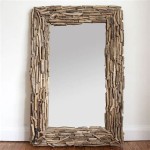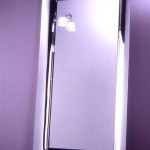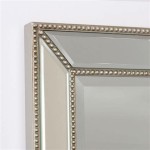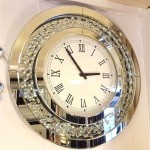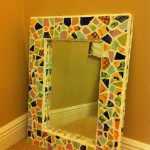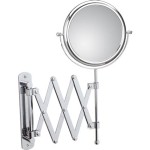Do Bathroom Mirrors Need To Be Sealed?
Bathroom mirrors face a constant barrage of moisture and humidity. This exposure can lead to several issues, including silvering degradation, spot etching, and even structural damage to the mirror itself. Sealing a bathroom mirror adds a layer of protection against these potential problems, extending its lifespan and maintaining its reflective qualities.
Why Seal a Bathroom Mirror?
The primary reason for sealing a bathroom mirror is to prevent moisture penetration. Unsealed mirrors are susceptible to water seeping into the edges and backing, which can cause the reflective silvering to peel or become discolored. This damage is often irreversible and necessitates mirror replacement. Sealing creates a barrier, effectively waterproofing the mirror and preventing this type of damage.
Types of Mirror Sealants
Several sealant options provide varying levels of protection and longevity. Choosing the appropriate sealant depends on the type of mirror, the surrounding material (e.g., tile, drywall), and the specific bathroom environment. Commonly used sealants include:
- Silicone Sealant: A popular choice due to its excellent adhesion, flexibility, and water resistance. Silicone sealant comes in various colors, allowing for a seamless match with the mirror and surrounding materials.
- Mirror Mastic: Specifically designed for mirror installation and sealing. Mirror mastic provides a strong bond and excellent moisture protection. However, it can be more difficult to apply and clean up than silicone sealant.
- Neutral Cure Silicone: This type of silicone sealant is less likely to react with certain mirror backings or surrounding materials. It’s a good option for sensitive applications.
How to Seal a Bathroom Mirror
Proper application is crucial for effective sealing. Before applying any sealant, ensure the mirror and surrounding surfaces are clean and dry. Any existing mildew or caulk should be completely removed. Here's a general process for sealing a bathroom mirror:
- Prepare the Area: Clean the edges of the mirror and the surrounding wall with a suitable cleaner and allow it to dry completely. Use masking tape along the edges of the mirror to create clean sealant lines.
- Apply the Sealant: Apply a continuous bead of sealant along the edges where the mirror meets the wall. Avoid gaps or breaks in the sealant bead.
- Smooth the Sealant: Use a wet finger or a sealant smoothing tool to create a smooth, concave surface on the sealant bead. This helps ensure proper adhesion and a professional finish.
- Remove Masking Tape: Carefully remove the masking tape before the sealant fully cures. This prevents tearing or pulling the sealant.
- Allow to Cure: Allow the sealant to cure completely according to the manufacturer's instructions before exposing it to moisture.
Signs a Mirror Needs Resealing
Even sealed mirrors can eventually require resealing. Indicators that a mirror needs resealing include:
- Peeling or Discolored Silvering: This is a clear sign of moisture penetration and damage to the reflective backing.
- Cracked or Deteriorated Sealant: If the existing sealant shows signs of cracking, peeling, or discoloration, it's no longer providing adequate protection.
- Visible Mold or Mildew: The presence of mold or mildew around the mirror edges indicates moisture accumulation and the need for resealing.
Benefits of Professional Sealing
While sealing a bathroom mirror can be a DIY project, professional installation offers several advantages. Professionals have the experience and expertise to select the appropriate sealant for the specific application and ensure proper application techniques. They also possess specialized tools and equipment to achieve a clean, professional finish. Professional installation can minimize the risk of sealant failure and maximize the lifespan of the mirror.
Maintaining a Sealed Bathroom Mirror
Proper maintenance can extend the lifespan of both the mirror and the sealant. Regular cleaning with a mild glass cleaner and a soft cloth can prevent the buildup of soap scum and mineral deposits. Avoid abrasive cleaners, which can scratch the mirror surface and damage the sealant. Regularly inspect the sealant for signs of deterioration and reseal as needed.
By understanding the importance of sealing and using the right techniques, bathroom mirrors can be protected from the damaging effects of moisture and humidity, ensuring their longevity and aesthetic appeal.

Everything You Need To Know About Mirror Rot House Of Mirrors Glass

How Do I Stop My Bathroom Mirror From Rusting Gcs Glass

How To Seal Mirrors For Bathroom Ehow

Bathroom Mirror Frames 2 Easy To Install Sources A Diy Tutorial Retro Renovation

Diy Bathroom Mirror Frame Without Removing Clips Her Happy Home

Bathroom Mirror Great Ideas For Your

What Type Of Mirror Is Best For Bathrooms Ledmyplace

3 Signs Your Led Bathroom Mirror Needs Immediate Attention Whole Manufacturer In China

4 Pieces Every Small Bathroom Needs 2024 On Roomhints Com

Diy How To Frame A Builder Grade Bathroom Mirror Home And Hallow

